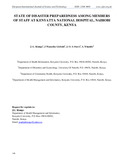| dc.contributor.author | Gichuhi, Wanyoike | |
| dc.contributor.author | Gichuhi, J Wanyoike | |
| dc.contributor.author | Osero, JOS | |
| dc.contributor.author | Yitambe, A | |
| dc.date.accessioned | 2015-07-14T06:21:09Z | |
| dc.date.available | 2015-07-14T06:21:09Z | |
| dc.date.issued | 2015-06 | |
| dc.identifier.citation | Kiongo, J. G., Gichuhi, J. W., Osero, J. O. S., Yitambe, A., & Kiongo, J. G. (2015). State of disaster preparedness among members of staff at Kenyatta national Hospital, Nairobi County, Kenya. eijst, 4(5). PP. 146-155 | en_US |
| dc.identifier.uri | http://eijst.org.uk/images/frontImages/gallery/Vol._4_No._5/17._146-155.pdf | |
| dc.identifier.uri | http://hdl.handle.net/11295/87617 | |
| dc.description.abstract | Objective:
To find out the state of disaster preparedness amo
ng members of staff at Kenyatta National
Hospital (KNH), Nairobi, Kenya.
Design:
Sectional descriptive study.
Setting
: Kenyatta National Hospital, Nairobi, Kenya.
Subjects:
Three hundred sixty one respondents
.
Results:
The study established that terrorist attack (84%) i
s the leading potential threat followed by fire
(81%). Most members of staff of KNH (66.7%) were aw
are of the existence of a disaster plan in the hosp
ital.
Majority (65.3%) of the respondents felt that evacu
ation plans are inadequate. The study found out th
at
58% of the respondents had no training on disaster
management. Majority of the respondents indicated t
hat
there was no adequate infrastructure to manage disa
ster with 62.3 % indicating there was inadequate fi
re
fighting equipments. There was no difference on dis
aster management knowledge among male and female
(P=0.631;
570
.9
2
=
χ
) respondents. In contrast, a higher proportion (12
%) with 50 years and above had
excellent knowledge compared to those with between
31-40 years. The respondents’ age was associated wi
th
knowledge on disaster management knowledge (P<0.05)
. In terms of training on disaster management,
those trained had good knowledge (50.7%) as compare
d to 26.8% not trained and was statistically
significant (P<0.05). Similarly, years worked in KN
H played a role on knowledge on disaster management
.
There was a larger proportion (31.3%) of those who
have worked between 10-15 years when compared to
49.5% who have worked between 15-20 years.
Conclusion
The KNH has the responsibility to ensure that all t
he members of the staff are familiar with the disas
ter
preparedness contents and management plan. There wa
s inadequate training in disaster preparedness by
the member of staff and emergency drills were not h
eld to evaluate the disaster response. There is no
adequate infrastructure in the hospital to handle t
he emergencies as established by this study. The st
udy has
established that the hospital need to adequately lo
ok into the up-gradation of the infrastructure to e
nhance
the efficiency of service delivery in times of disa
ster as well as performing emergency trainings and
drills | en_US |
| dc.language.iso | en | en_US |
| dc.publisher | University of Nairobi | en_US |
| dc.title | State of disaster preparedness among members of staff at Kenyatta national Hospital, Nairobi County, Kenya | en_US |
| dc.type | Article | en_US |
| dc.type.material | en_US | en_US |

